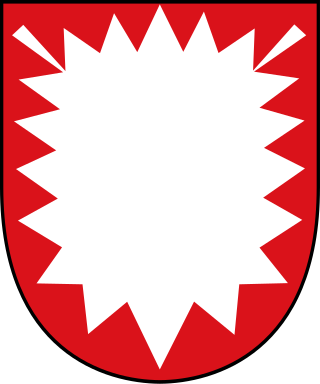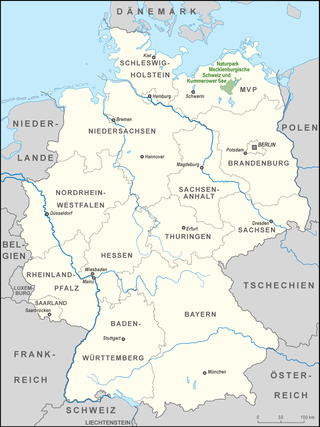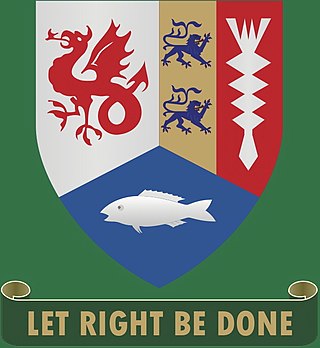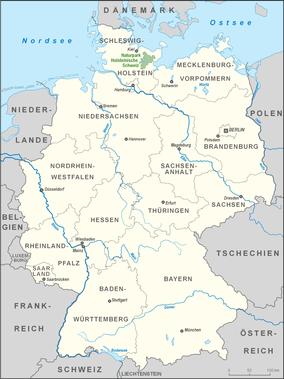
Plön is a district in Schleswig-Holstein, Germany. It is bounded by the districts of Ostholstein and Segeberg, the city of Neumünster, the district of Rendsburg-Eckernförde, the city of Kiel and the Baltic Sea.

Plön is the district seat of the Plön district in Schleswig-Holstein, Germany, and has about 8,700 inhabitants. It lies right on the shores of Schleswig-Holstein's biggest lake, the Great Plön Lake, as well as on several smaller lakes, touching the town on virtually all sides. The town's landmark is Plön Castle, a chateau built in the 17th century on a hill overlooking the town.

Segeberg is a district in Schleswig-Holstein, Germany. It is bounded by the districts of Pinneberg, Steinburg and Rendsburg-Eckernförde, the city of Neumünster, the districts of Plön, Ostholstein and Stormarn, and the city state of Hamburg.

Holstein is the region between the rivers Elbe and Eider. It is the southern half of Schleswig-Holstein, the northernmost state of Germany.

Preetz is a town southeast of Kiel in the district of Plön, in Schleswig-Holstein, Northern Germany. Preetz is also known as "Schusterstadt" named after shoemakers who used to live and work in this town. Preetz has a population of about 16,000 and is the largest city in the district of Plön.
A little Switzerland or Schweiz is a landscape, often of wooded hills. This Romantic aesthetic term is not a geographic category, but was widely used in the 19th century to connote dramatic natural scenic features that would be of interest to tourists. Since it was ambiguous from the very beginning, it was flexibly used in travel writing to imply that a landscape had some features, though on a much smaller scale, that might remind a visitor of Switzerland.

The Großer Plöner See or Lake Plön is the largest lake (30 km2) in Schleswig-Holstein, Germany. It is located near the town of Plön. Its main tributary, as well as its main outflow, is the River Schwentine.

Holstein Switzerland is a hilly area with a patchwork of lakes and forest in Schleswig Holstein, Germany, reminiscent of Swiss landscape. Its highest point is the Bungsberg. It is a designated nature park as well as an important tourist destination in Northern Germany situated between the cities of Kiel and Lübeck.

The Schleswig-Holstein Uplands or Schleswig-Holstein Morainic Uplands is one of the three landscapes of the German state of Schleswig-Holstein; the others being the marsch and the geest. In addition, the gently rolling hills or Hügelland of the Baltic Uplands, the many small lakes and the long, deep embayments (Förde) formed by the moraines of the Weichselian Ice Age are characteristic features of the area. Its best-known towns are Kiel, Lübeck and Flensburg. The highest elevation in the area is the Bungsberg in the region known as Holstein Switzerland. On the Bungsberg is the only ski lift in the state.

Holsteinische Schweiz station is a railway station by the Kellersee lake on the Malente-Gremsmühlen–Lütjenburg railway in Schleswig-Holstein. It was opened on 25 May 1890. The entire route was built due to the efforts of businessman Johannes Janus, who ran the Hotel Holsteinische Schweiz after which the station was named.

The Bundesstraße 430 is a German federal road or Bundesstraße and the east-west link between Dithmarschen and Holstein in the southern part of the state of Schleswig-Holstein.

The Kiel–Lübeck railway is a non-electrified, mostly single-track railway line in eastern Schleswig-Holstein in north Germany. It links Kiel and Lübeck, the only two large cities in the state. Passenger services on the 81-kilometre route are currently (2010) operated by DB Regio.

Hohwacht Bay is a wide bay in the state of Schleswig-Holstein on Germany's Baltic Sea coastline. It is named after the village and seaside resort of Hohwacht. The nearest large town is Oldenburg in Holstein, about 5 kilometres inland. A number of nature reserves fringe the bay and there is a military training area along its eastern shore.

The Malente–Lütjenburg railway was a standard gauge, branch line in the north German state of Schleswig-Holstein. It was built by the businessman, Janus, who ran the Holsteinische Schweiz hotel, that gave its name to the local station on the line. It is currently closed.

The Mecklenburg Switzerland and Lake Kummerow Nature Park lies in the northern part of the Mecklenburg Lake District in the districts of Mecklenburgische Seenplatte and Rostock in the German state of Mecklenburg-Vorpommern between the towns of Dargun, Demmin, Teterow, Malchin and Waren (Müritz). It was created in 1997. The total area of the nature park is 673 km2. 19 percent of this area is covered by woodland, ca. 10 percent by lakes and rivers, the rest is cultural landscape. There are 3 large lakes in the naturepark: Lake Malchin, Lake Kummerow and Lake Teterow. The Peene is the largest river in the park. The features that make it special are the large lakes, the riverine landscapes, the centuries-old oaks, the castles, the manor houses and their rural estates. The nature park is well known as a stopover for Nordic ducks. It is easily reached from the A 19, motorway junctions Krakow am See and Güstrow, or the A 20, junctions Tessin and Bad Sülze. The head office of the nature park administration is in Basedow.

King Alfred School, Plön, was a boarding school for children whose parents were British military or civil service personnel working in Germany; between 1948 and 1959, it educated approximately 4000 pupils aged between 11 and 18 years old.

The Hütten Hills are an area of upland, up to 105.8 m above sea level (NHN), roughly west of the town of Eckernförde in the county of Rendsburg-Eckernförde in the North German state of Schleswig-Holstein. They lie within the Hütten Hills Nature Park.

The German-Luxembourg Nature Park is a cross-border nature park, which was established on 17 April 1964 by state treaty between the German state of Rhineland-Palatinate and the Grand Duchy of Luxembourg. It thus became the first cross-border nature park in Western Europe. On the German side Naturpark Südeifel is providing services for visitors.

Franconian Switzerland-Veldenstein Forest Nature Park is a nature park in North Bavaria. The nature park was established in 1995 and it covers an area that is almost coextensive with the natural region major unit of Northern Franconian Jura, the park being slightly larger.



















